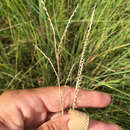pms
nòm ant ël fil


This species is used for fodder.
Paspalum plicatulum is a species of grass known by the common name brownseed paspalum. In Brazil its names include capim coquerinho, felpudo and pasto-negro. It is called zong zi que bai in Chinese and herbe à cheval in French. In South America its names include camalote, gamelotillo, and hierba de cepa.[1] It is native to the Americas, where it occurs in the southeastern United States, Mexico, the Caribbean, and parts of South America.[2][1]
This rhizomatous perennial grass has thick stems which can exceed 1 metre (3 ft) in height. The leaf blades are up to 35 centimetres (14 in) long. The inflorescence is a panicle with up to 7 branches. The paired spikelets are generally oval in shape and are brown in color.[2]
In its native range this grass grows in disturbed areas as well as prairies and forests.[2] It is planted in many areas of the world to feed livestock.[1]
The seeds provide food for birds.[3] It is used as a pasture grass and it can be made into hay. It can be grown on low-fertility soils. Cultivars include 'Bryan', 'Hartley', and 'Rodd's Bay'.[1]
Paspalum plicatulum is a species of grass known by the common name brownseed paspalum. In Brazil its names include capim coquerinho, felpudo and pasto-negro. It is called zong zi que bai in Chinese and herbe à cheval in French. In South America its names include camalote, gamelotillo, and hierba de cepa. It is native to the Americas, where it occurs in the southeastern United States, Mexico, the Caribbean, and parts of South America.
This rhizomatous perennial grass has thick stems which can exceed 1 metre (3 ft) in height. The leaf blades are up to 35 centimetres (14 in) long. The inflorescence is a panicle with up to 7 branches. The paired spikelets are generally oval in shape and are brown in color.
In its native range this grass grows in disturbed areas as well as prairies and forests. It is planted in many areas of the world to feed livestock.
The seeds provide food for birds. It is used as a pasture grass and it can be made into hay. It can be grown on low-fertility soils. Cultivars include 'Bryan', 'Hartley', and 'Rodd's Bay'.
Paspalum plicatulum est une espèce de plantes monocotylédones de la famille des Poaceae, sous-famille des Panicoideae, originaire d'Amérique du Sud et d'Amérique centrale. Ce sont des plantes herbacées vivaces, cespiteuses, aux tiges (chaumes) dressées ou géniculées ascendantes pouvant atteindre 120 cm de long, aux inflorescences composées de racèmes.
Selon kerman & Riveros (1990), originaire de l’Amérique du Sud et du centre où il est présent naturellement, Paspalum plicatulum est devenue au fur des années une espèce très répandue dans le monde, notamment en Afrique (Kenya, Côte d'Ivoire, Guinée) en Australie, aux États-Unis, en Océanie (Fidji) et en Asie du Sud-Est (Philippines, Thaïlande, Indonésie, Malaisie et Chine).
Paspalum plicatulum est une graminée vivace, touffue, cespiteuse pouvant atteindre une hauteur de 1,2 mètre. Les feuilles vert tendre, pliées à la base, sont velues et font jusqu’à 10-15 cm de long, pour 3 à 7 mm de large. La gaine habituellement glabre présente une ligule membraneuse de 1-3 mm de longueur.
L’inflorescence est une panicule composée de 10-13 racèmes de 2-10 cm de long ; les épillets par paires (dont une des paires parfois peu développée) de forme ovoïde-ellipsoïdale de dimension 2-3 mm × 1,5-2mm. Caryopse aussi gros que l'épillet, brun foncé, brillant. Les graines mûres sont brun foncé et les épillets sont extrêmement froissés sur le côté plat (USDA NRCS, 2002).
Selon Tropicos (1 avril 2018)[2] (Attention liste brute contenant possiblement des synonymes) :
Paspalum plicatulum est une espèce de plantes monocotylédones de la famille des Poaceae, sous-famille des Panicoideae, originaire d'Amérique du Sud et d'Amérique centrale. Ce sont des plantes herbacées vivaces, cespiteuses, aux tiges (chaumes) dressées ou géniculées ascendantes pouvant atteindre 120 cm de long, aux inflorescences composées de racèmes.
Paspalum plicatulum là một loài thực vật có hoa trong họ Hòa thảo. Loài này được Michx. mô tả khoa học đầu tiên năm 1803.[1]
Paspalum plicatulum là một loài thực vật có hoa trong họ Hòa thảo. Loài này được Michx. mô tả khoa học đầu tiên năm 1803.
高雀稗(学名:Paspalum plicatulum)为禾本科雀稗屬下的一个种。
|access-date=中的日期值 (帮助)